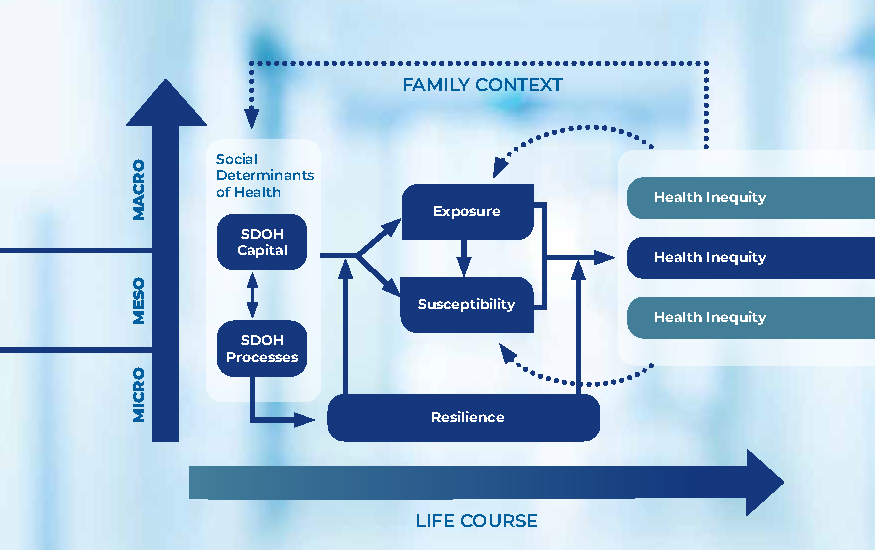Groundbreaking Research Conceptualizing the Mechanisms of Social Determinants of Health (SDOH) Now Available in Open-Access Paper
The paper, published in Milbank Quarterly, pioneers a dynamic framework for mitigating harmful SDOH that has broad application for practitioners, educators, researchers, policy makers and others working to advance health equity.

A review of landmark research on SDOH conducted by the Center for Latino Adolescent and Family Health (CLAFH) at the Duke School of Nursing (DUSON), along with a description of the novel framework for harmful SDOH mitigation this research inspired, is now available in an open-access paper in the most recent edition of the Milbank Quarterly. Individuals may access and download this groundbreaking paper at this link.
Written by Marco-Thimm Kaiser, Adam Benzekri and Vincent Guilamo-Ramos, the paper, entitled “Conceptualizing the Mechanisms of Social Determinants of Health: A Heuristic Framework to Inform Future Directions for Mitigation” lays out an innovative road map for mitigating harmful SDOH that more adequately considers the roles of exposure, susceptibility, social processes and resilience in shaping health inequity.
The current dominant approach to mitigating SDOH in healthcare and public health settings often relies on a linear understanding of SDOH, implying harmful SDOH cause increased community or individual vulnerability which then, in turn, causes health inequity. However, important constructs and mechanisms that are identified in the scientific literature are missing from this picture. This paper synthesizes existing SDOH research into a new, dynamic framework that provides policymakers, practitioners, and researchers with a customizable template for conceptualizing and operationalizing key mechanisms that represent intervention opportunities for mitigating the impact of harmful SDOH.
“In light of scarce existing SDOH mitigation strategies, this new framework addresses an important research-to-practice translation gap and missed opportunity for advancing health equity,” said Vincent Guilamo-Ramos, PhD, MPH, LCSW, RN, ANP-BC, PMHNP-BC, FAAN, dean, Duke University School of Nursing, vice chancellor, nursing affairs, Duke University and the senior author on the paper. “Unlike the static frameworks most commonly used to mitigate harmful SDOH, the DUSON & CLAFH framework is an evolved dynamic process model that identifies specific core factors that create and perpetuate health inequities and explains the relationship between these factors. Our framework’s more comprehensive consideration of SDOH mechanisms and constructs provides a more effective roadmap for educators, practitioners, researchers, policymakers and other stakeholders designing programs to mitigate harmful SDOH.”
The following constructs and mechanisms are cornerstones of the CLAFH/DUSON Framework for mitigating the effects of harmful SDOH:
- Social Processes and Capital: address harmful policies, norms, and structural inequities like racism, sexism, homophobia, etc. in addition to addressing inequitable distributions of resources and opportunities such as income, education, and housing.
- Exposure: assess and address the impact of harmful SDOH on environmental and behavioral risks.
- Susceptibility: assess and address the impact of harmful SDOH on biological risks on morbidity and mortality.
- Resilience: promote and facilitate the ability to thrive despite adversity at the individual, system, and community levels.
Another key finding described in the paper is that labeling individuals or communities as “vulnerable” reflects a deficiency-focused perspective and does not adequately emphasize the importance of understanding and addressing the specific drivers of health inequities. Vulnerability has often been used to describe groups or communities experiencing health inequities—predominantly along lines of race and ethnicity, socioeconomic status, and sexual orientation and gender identity. While harmful SDOH do contribute to negative health outcomes for some individuals and communities, they are not deterministic. The CLAFH/DUSON Framework explains how to bolster strength-based resilience factors that set communities up to thrive despite structural adversity.
To learn more about the Framework and how it can be applied, visit DUSONTrailblazer.com. This online hub explains and illustrates the new framework in an accessible and easily digestible format, and features a tool kit with an open access lecture and companion slide deck. Visitors of the site are invited to take an online quiz to test their knowledge of SDOH and share the quiz on social media to amplify the conversation.